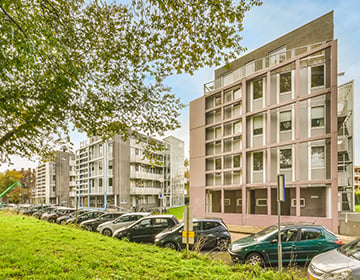- Home
- Blog
- Buying Guide
- How to Buy a Multifamily Property: Complete Investment Guide
How to Buy a Multifamily Property: Complete Investment Guide
Multifamily properties have shown remarkable resilience, maintaining strong occupancy rates. These buildings with multiple rental units provide investors with distinct advantages compared to single-family homes. For first-time buyers, they offer an accessible entry point into income-generating real estate. For experienced investors, they present compelling opportunities for stable cash flow and portfolio growth.
What is a Multifamily Home?
 A multifamily home or property is a residential building with two or more living units. Common types include, but are not limited to, small apartment buildings and duplexes. Buying a multifamily property for sale is a popular investment option due to the consistent income potential and market resilience.
A multifamily home or property is a residential building with two or more living units. Common types include, but are not limited to, small apartment buildings and duplexes. Buying a multifamily property for sale is a popular investment option due to the consistent income potential and market resilience.
Unlike single-family properties, they generate multiple income streams from various tenants. This reduces the financial impact of vacancy periods.
Multifamily Property Pros and Cons
Understanding the advantages and challenges of multifamily investing is important to make good decisions.
Advantages
- Steady Cash Flow: With multiple units generating reliable income, one vacancy does not affect your entire rental income stream.
- Operational Efficiency: Buying a 10-unit multifamily property is easier to manage than 10 separate properties. Additionally, centralizing maintenance, repairs, and property management reduces per-unit operational costs.
- Easier Financing: These properties are seen as lower-risk investments by lenders. The diversified rental income plays the biggest role here.
- Strong Appreciation Potential: Investing in multifamily properties often delivers solid long-term returns due to stable rental income, market resilience, and consistent rental demand.
Challenges to Consider
- Higher Upfront Investment: Buying a multifamily home comes with a larger down payment. Initial management expenses may also be higher, especially from single-family property experience.
- More Complex Management: With multiple units, landlord responsibilities multiply. Maintenance requests, rent collection, and tenant relations require more time and attention than single-family properties.
- Market Considerations: Like all investments, multifamily properties are influenced by local market conditions. Since they need higher capital commitments, thorough location research and market analysis are important.
How to Assess a Profitable Multifamily Property
Understanding how to value a multifamily property and analyze its income potential is important.
The property's true earning potential is reflected in its Net Operating Income (NOI). It is calculated by subtracting all operating expenses from the total annual rental income. These expenses include property taxes, insurance, maintenance, management fees, and a vacancy allowance of 5-10%.
 Cash flow analysis is equally important for your investment returns. Calculate your monthly mortgage payment and subtract it from the monthly NOI. Positive cash flow demonstrates that the property is paying for itself and generating additional income for you.
Cash flow analysis is equally important for your investment returns. Calculate your monthly mortgage payment and subtract it from the monthly NOI. Positive cash flow demonstrates that the property is paying for itself and generating additional income for you.
Additionally, conducting market comparisons validates your investment decision. Compare the asking price of similar multifamily properties for sale in the area and ensure the numbers align with current market conditions.
What to Consider Before Buying a Multifamily Property
While multifamily property investments provide excellent opportunities, there are things to assess for a successful purchase for investors. Here are the key factors to evaluate when buying a multifamily property.
Property Assessment
Evaluating whether the property is in good condition forms the foundation of your investment decision. The building's age, foundation, roof, and plumbing systems all impact both immediate costs and long-term profitability.
Also consider the unit mix and layouts, especially according to local rental demand. Research what unit sizes rent best locally, and assess whether the property meets these market preferences.
Neighborhood Analysis for Profitability
Take time to research the neighborhood's potential. Transportation access is essential for tenant satisfaction. Public transit options like buses and highway access make the location more attractive to renters. Consider the property's distance to major job centers and employment hubs.
The best places to buy multifamily properties offer access to a wide range of amenities. Shopping, healthcare, and schools (even for non-family tenants) enhance the appeal.
Additionally, analyze key market indicators such as average rents, vacancy rates, and appreciation trends to validate your investment thesis.
Due Diligence Checklist for Multifamily Real Estate Investment
When conducting final assessments of the property's condition, engage professional inspectors for comprehensive evaluations. Request detailed assessments of structural, mechanical, and environmental factors.
Verify all financial documentation thoroughly. Collect current rent rolls as well as three years of rental history. Reviewing actual operating expenses is equally crucial for accurate projections.
Ensure legal compliance across all requirements. This includes zoning verification, active rental permits, and current code compliance status.
Review title and legal documentation. Confirm clear ownership, identify any existing liens, and understand relevant local regulations.
How Financing Works for Multifamily Investments vs Single-Family Properties
 The initial financing process for multifamily properties can be more complex than single-family investments. However, the income-generating potential of these properties makes it easier to finance larger loans.
The initial financing process for multifamily properties can be more complex than single-family investments. However, the income-generating potential of these properties makes it easier to finance larger loans.
The down payment requirements are higher for multifamily properties. They typically require a 20-25% down payment compared to lower options available for single-family homes. However, for multifamily investments, rental income counts toward your qualifying income immediately.
Documentation requirements are also more comprehensive. Besides standard mortgage documents, lenders require rent rolls, current lease agreements, and property expense history to verify the property's income potential.
Multifamily real estate investing combines steady income with long-term appreciation. While the due diligence process needs attention to detail, the financial rewards make this a compelling investment for both new and experienced investors.
Success in multifamily investing depends on thorough market knowledge, accurate property analysis, and experienced guidance throughout the process.
That's where TEKCE comes in. With deep market knowledge and proven expertise, we guide investors through every stage of their journey. Ready to explore multifamily investment opportunities? Reach out to find properties aligned with your goals.









